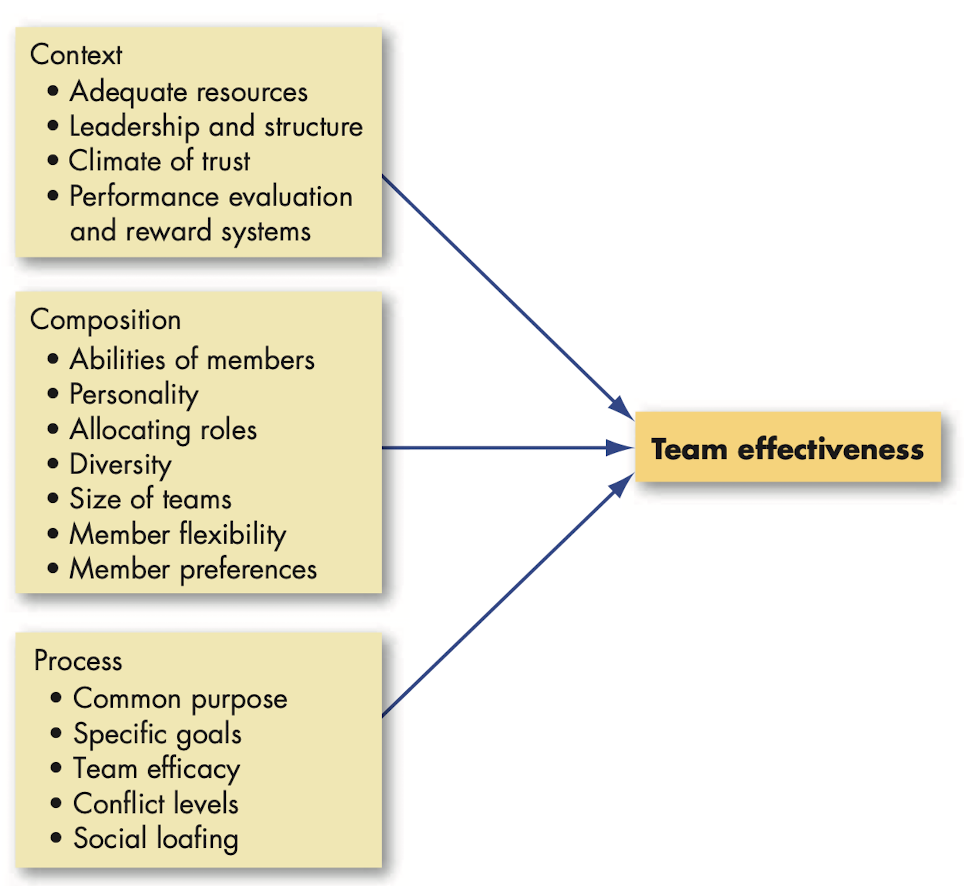
Chapter 10 - Understanding work teams
Difference between groups and teams
Work group: group that interacts primarily to share information and make decisions to help each group member fulfill his/her responsibilities.
Work team: group whose individual efforts result in performance that is greater than the sum of the individual inputs.
Types of teams
Problem-solving teams: groups of 5 to 12 employees from the same department who meet for a few hours each week to discuss ways of improving quality, efficiency and the work environment.
Self-managed teams: groups of 10 to 15 people who take on responsibilities of their former supervisors.
Cross-functional teams: employees from about the same hierarchical level, but from different work areas, who come together to accomplish a task.
Virtual teams: teams that use computer technology to tie together physically dispersed members in order to achieve a common goal.
Multi-team systems: collection of two or more interdependent teams that share a superordinate goal; a team of teams.
Creating effective teams

Context: what factors determine whether teams are successful
Team composition
Organizational demography: degree to which team members of a work unit share a common demographic attitude (sex, age), educational background or length of service in an organization and the impact of this attribute on turnover.
Team process
Reflexivity: team characteristic of reflecting on and adjusting the master plan when necessary.
Mental models: organized mental representations of the key elements within a team’s environment that team members share.
Turning individuals into team players
Selection: hiring team players
Training: creating team players
Rewarding: providing incentives to be a good team player
Chapter 10 - Understanding work teams
Difference between groups and teams
Work group: group that interacts primarily to share information and make decisions to help each group member fulfill his/her responsibilities.
Work team: group whose individual efforts result in performance that is greater than the sum of the individual inputs.
Types of teams
Problem-solving teams: groups of 5 to 12 employees from the same department who meet for a few hours each week to discuss ways of improving quality, efficiency and the work environment.
Self-managed teams: groups of 10 to 15 people who take on responsibilities of their former supervisors.
Cross-functional teams: employees from about the same hierarchical level, but from different work areas, who come together to accomplish a task.
Virtual teams: teams that use computer technology to tie together physically dispersed members in order to achieve a common goal.
Multi-team systems: collection of two or more interdependent teams that share a superordinate goal; a team of teams.
Creating effective teams

Context: what factors determine whether teams are successful
Team composition
Organizational demography: degree to which team members of a work unit share a common demographic attitude (sex, age), educational background or length of service in an organization and the impact of this attribute on turnover.
Team process
Reflexivity: team characteristic of reflecting on and adjusting the master plan when necessary.
Mental models: organized mental representations of the key elements within a team’s environment that team members share.
Turning individuals into team players
Selection: hiring team players
Training: creating team players
Rewarding: providing incentives to be a good team player
 Knowt
Knowt